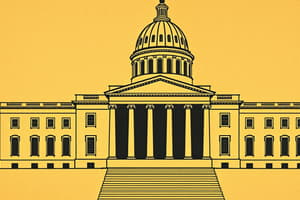Podcast
Questions and Answers
What is the purpose of the Senate in the United States Congress?
What is the purpose of the Senate in the United States Congress?
- To regulate commerce and coin money
- To represent the Union with 2 Senators for each state (correct)
- To declare war on behalf of the executive branch
- To create, eliminate, and fund Departments
The House of Representatives is made up of 100 members.
The House of Representatives is made up of 100 members.
False (B)
What are the two chambers of the United States Congress?
What are the two chambers of the United States Congress?
House of Representatives and Senate
The legislative branch of the U.S. government is primarily responsible for __________.
The legislative branch of the U.S. government is primarily responsible for __________.
Match the following branches of government with their primary functions:
Match the following branches of government with their primary functions:
How long are the terms for Representatives in Congress?
How long are the terms for Representatives in Congress?
Senators serve a term of 4 years.
Senators serve a term of 4 years.
What is the maximum number of terms a President can serve?
What is the maximum number of terms a President can serve?
The __________ outlines the country's policy and is presented before Congress each January.
The __________ outlines the country's policy and is presented before Congress each January.
Who is the current Vice President of the United States?
Who is the current Vice President of the United States?
What is a reason for the high reelection rate in Congress?
What is a reason for the high reelection rate in Congress?
The Supreme Court is the highest court in the land and serves as the last court of appeals.
The Supreme Court is the highest court in the land and serves as the last court of appeals.
Match the following powers of the President:
Match the following powers of the President:
What are the institutions that comprise the executive branch of the U.S. government?
What are the institutions that comprise the executive branch of the U.S. government?
Congress is hardly ever renewed due to extremely high __________ rate.
Congress is hardly ever renewed due to extremely high __________ rate.
The Supreme Court examines between __________ to __________ cases every year.
The Supreme Court examines between __________ to __________ cases every year.
Match the landmark cases with their significance:
Match the landmark cases with their significance:
Midterm elections typically have high voter turnout.
Midterm elections typically have high voter turnout.
Flashcards are hidden until you start studying
Study Notes
Founding Documents
- The US Constitution is a foundational document of the US Government, outlining the fundamental laws and principles.
- The Bill of Rights is an essential component of the Constitution, guaranteeing basic rights and freedoms to all citizens.
Branches of Government
- The US Government operates through a system of checks and balances, dividing power among three distinct branches: Legislative, Executive, and Judicial.
Legislative Branch - Congress
- Congress is a bicameral body, divided into two chambers: the House of Representatives and the Senate.
- The House of Representatives represents the people, with 435 members elected based on population.
- The Senate represents the states, with 100 members (two from each state).
- The Senate has additional powers, including confirming presidential nominations, ratifying treaties, and trying impeachment cases.
- Congress holds significant powers, such as voting on laws, regulating commerce, coining money, and declaring war.
- Congress creates, eliminates, and funds departments.
- Representatives are elected every two years, while senators serve six-year terms.
- Reelection rates in Congress are extremely high, exceeding 95% due to factors like campaign financing, no term limits, and low voter turnout during midterm elections.
- Challenges to representation exist due to factors like age, race, and gender disparities in Congress.
Executive Branch - Presidency
- The President is the head of the executive branch, responsible for implementing and enforcing laws passed by Congress.
- The President acts as the head of state, representing the US abroad.
- The President serves as commander-in-chief of the armed forces.
- The President's powers include vetoing legislation, nominating federal judges, and appointing high-ranking executive officers.
- The President is elected for a four-year term, with a maximum of two terms.
- The President delivers the State of the Union address annually to Congress, outlining the administration's policies and priorities.
- The President relies on a hierarchy of advisors and officials, including the Vice President, Cabinet, the Executive Office, and Federal Agencies.
- The Vice President supports the President, assumes the presidency in case of the President's death or resignation, and presides over the Senate.
- The Cabinet is comprised of heads of 15 executive departments, each responsible for a specific area of government.
Judicial Branch - Supreme Court
- The Supreme Court is the highest court in the US, serving as the final interpreter of the Constitution.
- The Supreme Court functions as the last court of appeals, reviewing lower court decisions.
- The Supreme Court consists of nine justices who are nominated by the president and confirmed by the Senate.
- Justices serve lifetime appointments.
- The Court hears 90-200 cases annually.
- Landmark Supreme Court cases have profoundly impacted American society, such as Plessy v.Ferguson (1896), Brown v.Board of Education of Topeka (1954), Roe v.Wade (1973), Lawrence v. Texas (2003), Obergefell v.Hodges (2015), Bostock v.Clayton County (2020), and Dobbs v.Jackson Women's Health Organization (2022).
Studying That Suits You
Use AI to generate personalized quizzes and flashcards to suit your learning preferences.




